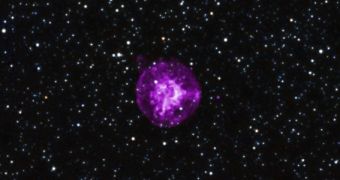Using data from the NASA Chandra X-ray Observatory, investigators were recently able to study the nearby supernova called SNR B0049-73.6. Their work revealed more details about how this object, and others in its class, appear and evolve over millions of years.
The object is located some 200,000 light-years away in the Small Magellanic Cloud, which is Milky Way's closest galactic neighbor. The SMC weighs just 7 billion solar masses, and has a diameter of around 7,000 light-years, as opposed to our galaxy's whopping 120,000 light-years.
Astrophysicists believe that supernovae are produced when the core of massive stars becomes unable to support nuclear fusion any longer. As this happens, the core implodes and ejects vast amounts of matter and energy into the surrounding space. The new study seems to confirm this hypothesis.
Wavelengths seen by Chandra are colored purple in the image. Additional data in red, green, and blue was collected from the 2MASS survey. The X-ray telescope has been orbiting our planet for more than 14 years, though its original mission was just 5 years.

 14 DAY TRIAL //
14 DAY TRIAL //